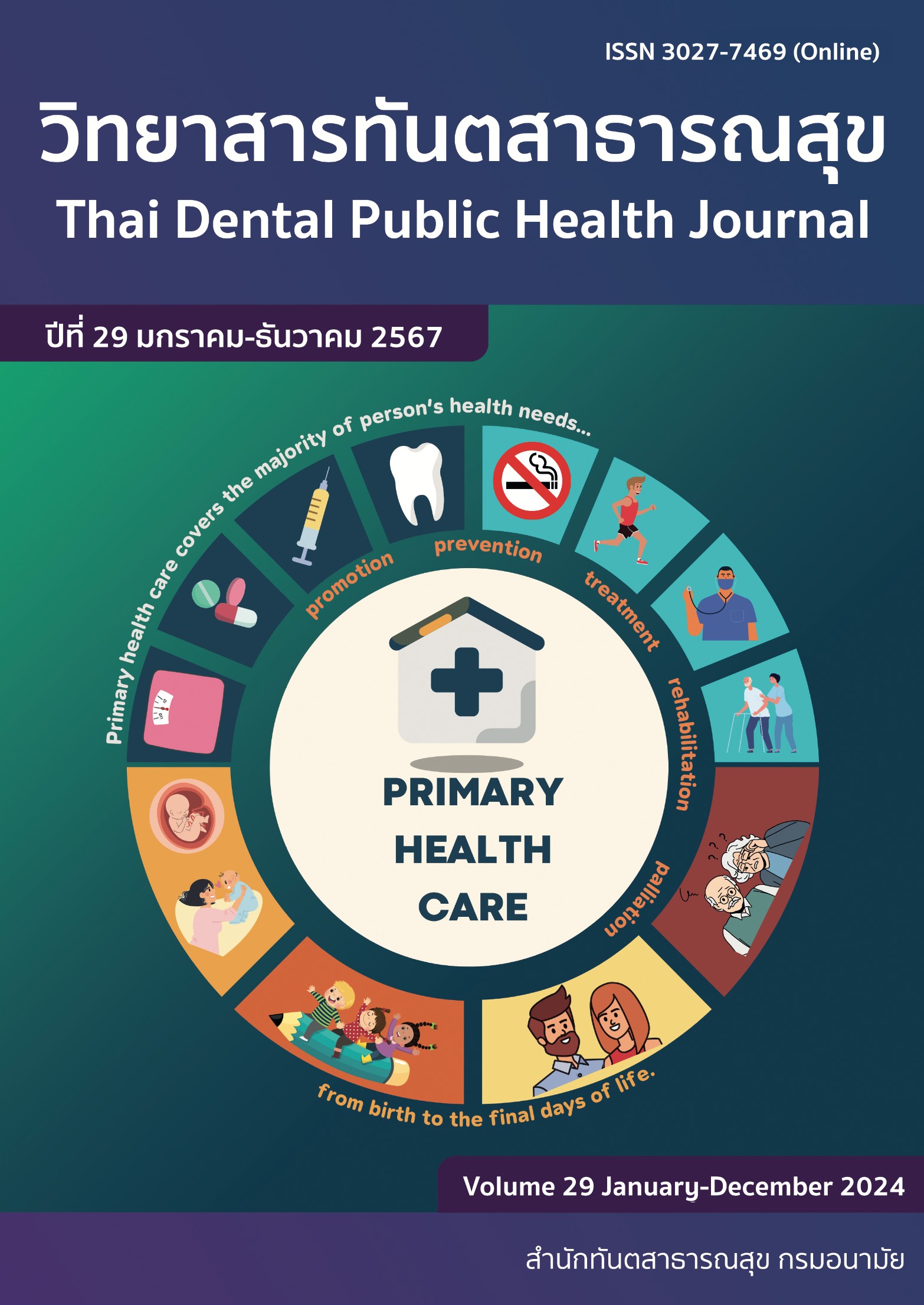Development an oral self-care behavior surveillance in working-age population
Main Article Content
Abstract
The objective of this study was to develop an oral self-care behavior surveillance process among working-age groups aged 15–59 years. A representative sample size in thirteen health regions was calculated using Cochran's formula. Randomization was used to select people in all provinces of the health regions. The required sample size was 2,628. The study was conducted according to the process of health behavior surveillance. Identify risk behaviors associated with oral diseases that needed to be monitored in the working-age group, including brushing teeth with fluoride toothpaste every day at least 2 minutes before bedtime, drinking sugar-sweetened beverages, smoking, and visiting a dentist at least once a year for oral checkup. Data were collected using a self-administered questionnaire through the H4U application between May and September 2021. The data were analyzed by descriptive statistics and Chi-square at the statistically significant level with p-value<0.05. The result showed that 29.6% of working people neglected to brush their teeth before bedtime with fluoride toothpaste daily, 80.0% drank sugar-sweetened beverages, 16.9% smoked, and 64.6% did not visit a dentist in the past year. The data on oral self-care behaviors was used to create an oral health promotion project integrated with health promotion in the workplace for the fiscal year 2022-2023. In addition, the data was used to develop methods to educate oral health care through infographics in the H4U application if the respondents had incorrect oral health care behaviors. This development aims to improve oral health literacy so working people have desirable oral care behaviors.
Downloads
Article Details

This work is licensed under a Creative Commons Attribution-NonCommercial-NoDerivatives 4.0 International License.
References
Bureau of Dental Health. The 8th national oral health survey report 2017. Bangkok: Department of Health; 2018. (in Thai)
Spanemberg JC, Cardoso JA, Slob EMGB, López-López J. Quality of life related to oral health and its impact in adults. J Stomatol Oral Maxillofac Surg 2019; 120(3): 234-9. doi:10.1016/j.jormas.2019.02.004.
World Health Organization. Global oral health status report: towards universal health coverage for oral health by 2030 [online]. 18 November 2022 [cited 2022 Nov 15]; Available from: URL:https://www.who. int/publications/i/item/9789240061484.
Petersen PE. The World Oral Health Report 2003: continuous improvement of oral health in the 21st century--the approach of the WHO
Global Oral Health Programme. Community Dent Oral Epidemiol 2003; 31 (Suppl 1): 3-23. doi:10.1046/j..2003.com122.x.
National Collaborating Center for Acute Care. Dental recall: recall interval between routine dental examinations. [online] October 2004 [cited 20 Dec 2022]; Available from: URL:https:/ /www.ncbi.nlm.nih.gov/books/NBK54536
Thivakorakot W. Associated factors of oral health status in working age population at Amphawa district, Samut Songkhram province. Reg 4-5 Med J 2017; 36(4): 237-49. (in Thai)
Department of Health Service Support. Health behaviors surveillance guideline. Bangkok: 25 Media Company Limited; 2021. (in Thai)
World Health Organization. Protocol for the evaluation of epidemiological surveillance systems. [online] February 1997 [cited 2023 Mar 31]; Available from: URL:http://apps. who.int/iris/bitstream/handle/10665/63639/WHO_EMC_DIS_97.2.pdf?sequence=1
Centers for Disease Control and Prevention. Behavioral risk factor surveillance system. [online] 16 May 2014 [cited 2022 Sep 15]; Available from: URL:https://www.cdc.gov/brfs s/about/index.htm
Centers for Disease Control and Prevention. National oral health surveillance system (NOHSS). [online] 1 April 2015 [cited 2022 Oct 1]; Available from: URL:https://www.cdc. gov/oralhealthdata/overview/nohss.html
Prasertsom P, Srithong N, Supanwiwat A. Develop of provincial oral health surveillance system in Thailand. JHEALTH 2013; 36(1): 95-109. (in Thai)
Graham H, White PC. Social determinants and lifestyles: integrating environmental and public health perspectives. Public Health 2016; 141: 270-8. doi:10.1016/j.puhe. 2016.09.019.
Battram DS, Piché L, Beynon C, Kurtz J, He M. Sugar-sweetened beverages: children's perceptions, factors of influence, and suggestions for reducing intake. JNEB 2016; 48(1): 27-34.e1. doi:10.1016/j.jneb.2015.08.015.
Chung A, Backholer K, Zorbas C, Hanna L, Peeters A. Factors influencing sweet drink consumption among preschool-age children: a qualitative analysis. Health Promot J Austr 2021; 32(1): 96-106. doi:10.1002/hpja.306.
The Food Commission. Supermarkets told to chuck snacks off the checkout! [online] 22 October 2003 [cited 2023 May 5]; Available from: URL:http://www.foodcomm. org.uk/articles/checkout_snacks/
Campbell S, James EL, Stacey FG, Bowman J, Chapman K, Kelly B. A mixed-method examination of food marketing directed towards children in Australian supermarkets. Health Promot Int 2014; 29(2): 267-77. doi:10.1093/heapro/das060.
Cohen DA, Babey SH. Candy at the cash register--a risk factor for obesity and chronic disease. N Engl J Med 2012; 367(15): 1381-3. doi:10.1056/NEJMp1209443.
Dixon H, Scully M, Parkinson K. Pester power: snackfoods displayed at supermarket checkouts in Melbourne, Australia. Health Promot J Austr 2006; 17(2): 124-7. doi:10.1071/he06124.
Weigel MM, Armijos RX. The Ecuadorian school food environment: association with healthy and unhealthy food and beverage consumption and BMI. Food Nutr Bull 2022; 43(4): 439-64. doi:10.1177/03795721221116447.
Kaewkamnerdpong I, Krisdapong S. The associations of school oral health-related environments with oral health behaviours and dental caries in children. Caries Res 2018; 52(1-2): 166-75. doi:10.1159/000485747.
National Statistical Office. The 2020 household survey on the use of information and communication technology. [online] 30 March 2021 [cited 2022 Sep 27]; Available from: URL:https://www.m-society.go.th/ewt admin/ewt/mso_web/article_attach/30156/24292.pdf
Lapponampai W, Pamonsinlapatham P. Mobile health application on smartphone. [online] 20 December 2018 [cited 2022 Sep 20]; Available from: URL:https://ccpe.pharmacy council.org/showfile.php?file=580
Brinkel J, Krämer A, Krumkamp R, May J, Fobil J. Mobile phone-based mHealth approaches for public health surveillance in sub-Saharan Africa: a systematic review. Int J Environ Res Public Health 2014; 11(11): 11559-82. doi:10.3390/ijerph111111559.
Namwong T, Saenkpak M, Thanapathomsinchai P, Duangkaew J, Khampat S, Wisitohachonchai P, et al. Development of COVID-19 surveillance system, Yasothorn province. Dis Control J 2021; 47(2): 1179-90. (in Thai)
Couch DL, Robinson P, Komesaroff PA. COVID-19 - extending surveillance and the panopticon. J Bioeth Inq 2020; 17(4): 809-14. doi:10.1007/s11673-020-10036-5.
Pitipat W. Determining the sample size. in Research methodology in dentistry. 2nd ed. Khon Khaen: Khon Khaen Univertsity Publishing; 2006. p. 157-86. (in Thai)
Phonsuk P. A guide to survey data on food consumption behavior and nutritional status of Thai people. [online] 13 May 2015 [cited 2022 Sep 10]; Available from: URL:http://fhpprogram.org/download/survey-eating-habit-thai/
National Statistical Office. The 2021 health behavior of population survey. Bangkok: Statistical Forecasting Division; 2021. (in Thai)


